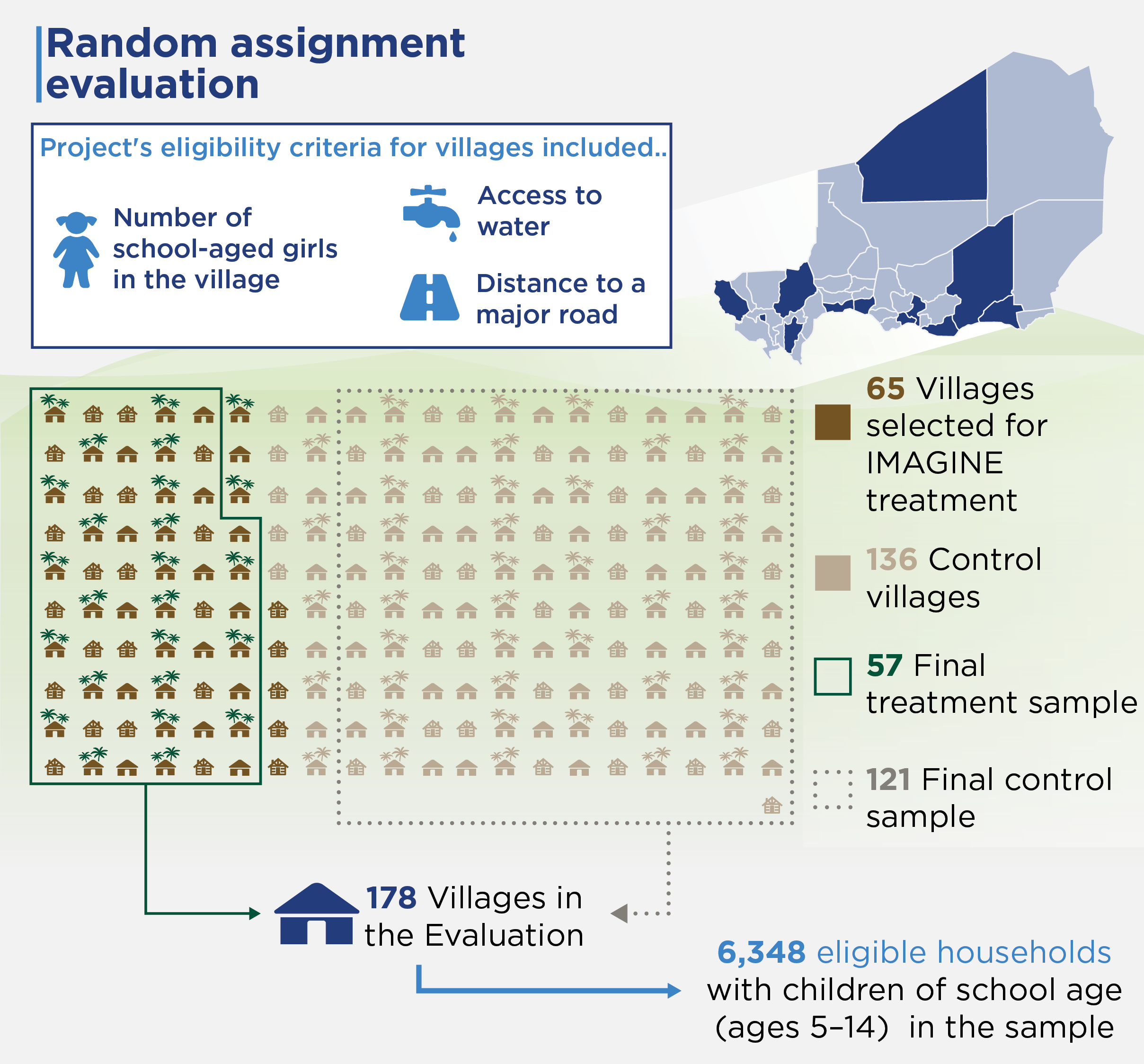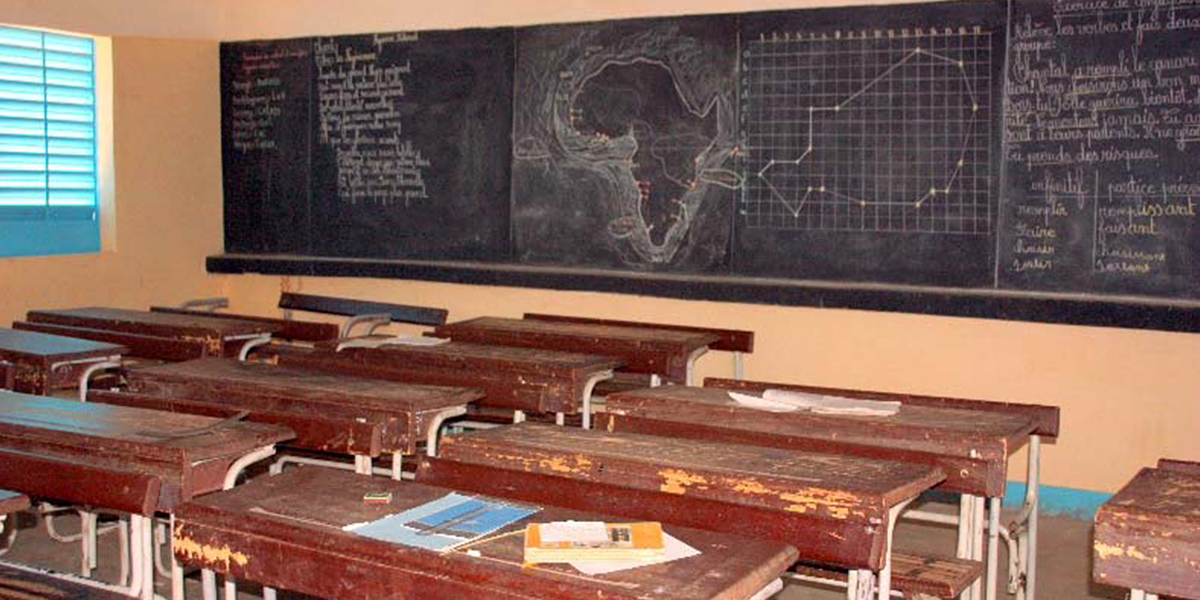Program Overview
MCC’s $23.1 million Niger Threshold Program signed in March 2008, was suspended in December 2009 due to a pattern of actions by the Government that were inconsistent with MCC’s eligibility criteria. The total Program budget was reduced to $16.9 million. At the time of the suspension, $12 million of the planned $18.1 million budget for the IMAGINE (Improve the Education of Girls in Niger) Project had been expended. The IMAGINE Project aimed to construct girl-friendly schools and implement complementary educational activities to improve education outcomes of primary school aged children.Evaluator Description
MCC commissioned Mathematica Policy Research to conduct an independent impact evaluation of IMAGINE. Full report results and learning: https://data.mcc.gov/evaluations/index.php/catalog/96/related_materials.
Key Findings
Improved School Infrastructure Quality
- Sixty-two functional, girl-friendly IMAGINE schools were built in 10 departments in Niger.
- IMAGINE schools were 40.8 percentage points more likely to have a functioning potable water source, 68.8 percentage points more likely to have separate latrines for boys and for girls, and 92.8 percentage points more likely to have separate housing for female teachers than schools in control villages.
Positive Impacts in Enrollment and Attendance
- Children in treatment villages were 8.3 percentage points more likely to be enrolled and 7.9 percentage points less likely to be absent for more than two consecutive weeks during the previous school year than children in control villages.
- The project impacts were larger for girls than for boys. For girls, the project had an 11.8 percentage point positive impact on enrollment and a 10.5 percentage point impact on attendance, whereas for boys, the impacts were 5.0 and 5.2 percentage points respectively.
Positive Impacts on Learning for Girls
- While the impact on test scores for boys were smaller and not statistically significant, girls in IMAGINE villages achieved relatively large and statistically significant impacts of 0.18 standard deviations on the math assessment and 0.10 standard deviations on the French assessment.
Evaluation Questions
This final impact evaluation was designed to answer the following questions:- 1 What is the availability and functionality of the infrastructure built under the IMAGINE Project?
- 2 Did the IMAGINE Project have any lasting impacts on key educational outcomes?
- 3 Were the impacts different for girls and boys and for children from households of different socioeconomic backgrounds?
Detailed Findings
Improved School Infrastructure Quality

A newly constructed IMAGINE school
Due to the Program’s abrupt ending, the majority of the complementary activities were not implemented, as project activities ended after 14 months instead of the intended 3 years. A few complementary activities, such as providing textbooks and materials for the schools, were fully implemented, whereas teacher training, mothers’ literacy training, and societal awareness campaigns were only partially implemented. Expected merit-based awards for female teachers, student tutoring, and hygiene and sanitation education were not implemented at all.
The IMAGINE Project had a positive effect on the overall number of classrooms and the number of classrooms made of durable material. Treatment group villages had on average 6.4 classrooms per school, of which 4.9 were made of durable materials (such as cement, tile or vinyl instead of natural materials). This is significantly larger than in control group villages, where 5.0 classrooms per school were available, of which 2.4 were made of durable materials. Moreover, three years after the completion of the Program, IMAGINE schools outperformed non-IMAGINE schools in every measure of school infrastructure quality. Compared to non-IMAGINE schools, IMAGINE schools were 40.8 percentage points more likely to have a functioning potable water source, 68.8 percentage points more likely to have separate latrines for boys and girls, and 92.8 percentage points more likely to have separate housing for female teachers.
Positive Impacts in Enrollment and Attendance

Pictured here are a standard classroom in the control villages (top) and a classroom made of natural materials (bottom). The cover photo shows a typical IMAGINE classroom.
For enrollment in the 2012–2013 school year, the project had larger effects for girls than for boys. The difference in girls’ enrollment between treatment and control villages was 11.8 percentage points (72.1 percent in treatment villages and 60.3 percent in control villages), while the difference for boys was 5 percentage points (75.0 percent in treatment villages and 70.0 percent in control villages).
IMAGINE also had positive impacts on absenteeism (unconditional on enrollment). Children in the treatment group were 7.9 percentage points less likely to report having been absent more than two consecutive weeks during the last school year, and 8.9 percentage points less likely to have been absent more than 14 days in the last month of school. The impact for girls was 5.3 percentage points greater, as girls in treatment villages were 10.5 percentage points less likely to report having been absent more than two consecutive weeks compared to girls in control villages. Boys in treatment villages were 5.5 percentage points less likely to report having been absent than boys in control villages.
Positive Impacts on Learning
Overall, the project had an impact on math scores, but no statistically significant impact on French language test scores. For math, children in treatment villages answered, on average, 0.5 more math questions correctly than those in control villages (out of a possible 18 questions) and scored 0.126 standard deviations higher on the total math assessment. For both math and French, the impacts for girls were consistently larger than the impacts for boys. However, the design and implementation of the project did not allow the evaluation to rigorously assess what components of the IMAGINE project drove these differential impacts.MCC Learning
- Multiple years of schooling might be required to achieve improvements in learning. Because children stay in school longer in IMAGINE villages than in non-IMAGINE villages, they have more of a chance to learn.
- The IMAGINE project had a large and significant impact on girls’ enrollment, attendance, and test scores. Viewed through the lens of the larger impact of the project for girls, it appears that there is indeed a “girl friendliness” about these schools that may be working.
- Higher quality infrastructure of schools in IMAGINE villages may be driving parents to enroll their children in school at a higher rate as well as encouraging more consistent attendance.
Evaluation Methods

Outcome data on the IMAGINE project were collected in late 2013, approximately three years after school construction ended. In all IMAGINE and control villages, randomly selected families with school-aged children responded to a household survey, as well as math and French assessments directly administered to children in the interviewed households. A village and school infrastructure questionnaire was also administered to a village leader, complemented by direct observation of school infrastructure and a village-level census.
Next Steps
The follow-up project, Niger Education and Community Strengthening (NECS), which included investments in all of the villages where IMAGINE constructed schools, was the subject of an impact evaluation. Endline data for that impact evaluation was collected in late spring 2016, and final evaluation report was published in 2017.2021-002-2614


